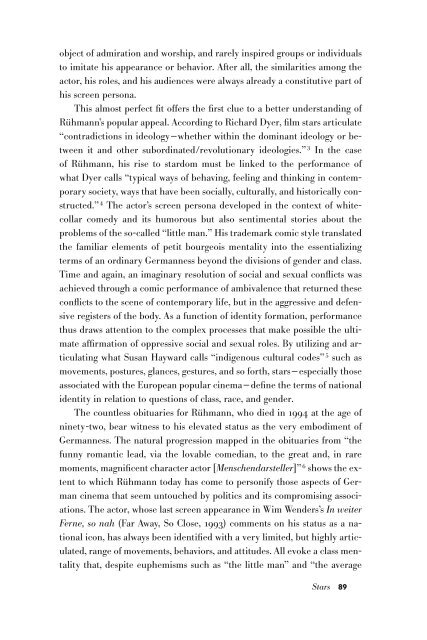Create successful ePaper yourself
Turn your PDF publications into a flip-book with our unique Google optimized e-Paper software.
object of admiration and worship, and rarely inspired groups or individuals<br />
to imitate his appearance or behavior. After all, the similarities among the<br />
actor, his roles, and his audiences were always already a constitutive part of<br />
his screen persona.<br />
This almost perfect fit offers the first clue to a better understanding of<br />
Rühmann’s popular appeal. According to Richard Dyer, film stars articulate<br />
“contradictions in ideology—whether within the dominant ideology or between<br />
it and other subordinated/revolutionary ideologies.” 3 In the case<br />
of Rühmann, his rise to stardom must be linked to the performance of<br />
what Dyer calls “typical ways of behaving, feeling and thinking in contemporary<br />
society, ways that have been socially, culturally, and historically constructed.”<br />
4 The actor’s screen persona developed in the context of whitecollar<br />
comedy and its humorous but also sentimental stories about the<br />
problems of the so-called “little man.” His trademark comic style translated<br />
the familiar elements of petit bourgeois mentality into the essentializing<br />
terms of an ordinary Germanness beyond the divisions of gender and class.<br />
Time and again, an imaginary resolution of social and sexual conflicts was<br />
achieved through a comic performance of ambivalence that returned these<br />
conflicts to the scene of contemporary life, but in the aggressive and defensive<br />
registers of the body. As a function of identity formation, performance<br />
thus draws attention to the complex processes that make possible the ultimate<br />
affirmation of oppressive social and sexual roles. By utilizing and articulating<br />
what Susan Hayward calls “indigenous cultural codes” 5 such as<br />
movements, postures, glances, gestures, and so forth, stars—especially those<br />
associated with the European popular cinema—define the terms of national<br />
identity in relation to questions of class, race, and gender.<br />
The countless obituaries for Rühmann, who died in 1994 at the age of<br />
ninety-two, bear witness to his elevated status as the very embodiment of<br />
Germanness. The natural progression mapped in the obituaries from “the<br />
funny romantic lead, via the lovable comedian, to the great and, in rare<br />
moments, magnificent character actor [Menschendarsteller]” 6 shows the extent<br />
to which Rühmann today has come to personify those aspects of German<br />
cinema that seem untouched by politics and its compromising associations.<br />
The actor, whose last screen appearance in Wim Wenders’s In weiter<br />
Ferne, so nah (Far Away, So Close, 1993) comments on his status as a national<br />
icon, has always been identified with a very limited, but highly articulated,<br />
range of movements, behaviors, and attitudes. All evoke a class mentality<br />
that, despite euphemisms such as “the little man” and “the average<br />
Stars 89

















